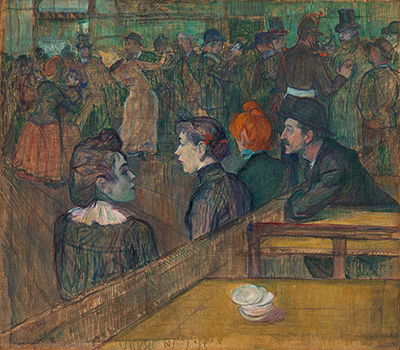The Moulin de la Galette was a painting created by Henri de Toulouse-Lautrec. In this renowned painting, Lautrec utilized the wood barrier as a metaphorical divide.
It shows a divide between the frenzied acts on the dance hall, shown as a background blur and the stillness of the waiting women in a bored demeanor. The women are accompanied by a proprietary male figure. To thin his pain Lautrec used turpentine, which was applied in loose washes. This technique was called the peinture à l'essence. It results in a look that seems unfinished, which suggests the shabbiness of his subject and immediacy of the observation made by the artist. The creation of this work of art was preceded by the Portrait of a Woman by the Window, which is considered a preparatory work to this painting. The style used, in many ways resonated with the work by Degas, which Lautrec considered an authority.
The composition is similar, where the viewer is left unclear as to what the painter wanted to single out in the painting. It only appears to capture a snapshot of a moment; depicting an atmosphere of reckless partying and fun where there are no prohibitions. Everything else in the painting appears to be subordinate to the sweet sinful permissiveness-taking place all around them.
The impressionists influenced Lautrec by a great deal when he joined the Montmartre scene. Lautrec had a great admiration for Degas, his neighbor. To create this work of art, he took the work of Renoir, another of his neighbor, which he redid in his own style. His subject was this painting, which depicts a dance at the Montmartre's hill. This was a place where the laborers and shop girls would show off their fancy footwork and finery. Pimps and prostitutes, who were a common subject in his paintings, were also often lurking in the shadows.
In the Renoir painting, the scene was depicted in impressionist light, showing dazzling lighting, thus brushing away the grimmer realities that the Moulin de la Galette was intended to depict. For a more realistic scene, Lautrec went to the dance hall and took sketches. He then returned to his studio where he made the final canvas.
The pain became an immediate hit within the press world. A reproduction was made in the Le Courrier français, which was a popular paper in Paris at the time. In 1889, it was featured in the Salon des Indépendants exhibition. The painting impressed even Theo Van Gogh (brother of Vincent). He shortly after wrote to his brother saying that he Lautrec's works had a powerful effect. He singled out the Moulin de la Galette as amongst those that impressed him the most.




